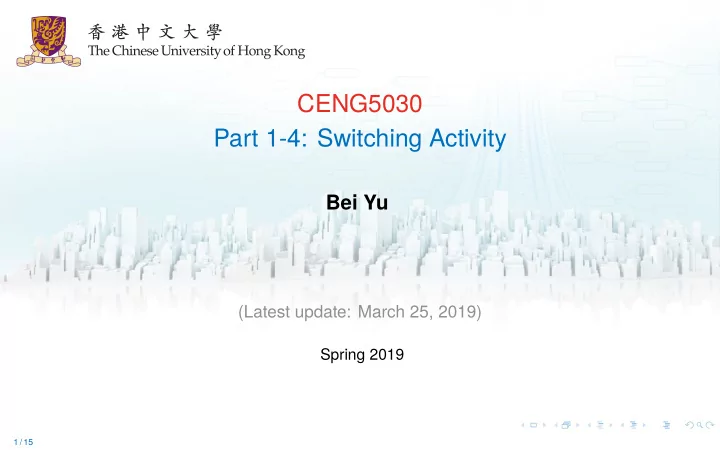

CENG5030 Part 1-4: Switching Activity Bei Yu (Latest update: March 25, 2019) Spring 2019 1 / 15
These slides contain/adapt materials developed by ◮ Sukumar Jairam et al. (2008). “Clock gating for power optimization in ASIC design cycle theory & practice.”. In: Proc. ISLPED , pp. 307–308 2 / 15
• C and A are intertwined • P = V 2 X f x C effective. • ILP + Frequency increase => Power problem!! • Factors affecting A: • Complexity of the processor • Exploitation of parallelism • Bit-width of its structures etc. • Optimized at the architectural and microarchitectural level • Can be changed by run-time optimizations • Factors affecting C: • Size of a processor’s structure • Organization to exploit locality • Manipulated at the circuit and process technology level • Determined at fixed design time 3 / 15
On Switching Activity • Idle-Unit switching activity: • Triggered by clock transitions in unused portions of hardware. • Idle –width switching activity : • Mismatch in the implemented and the actual width of processor structures. • Idle-capacity switching activity : When a program does not use the provided hardware architectures in their entirety. • • Parallel switching activity: Activity expended in parallel for performance • Cacheable switching activity: • Repetitive switching activity, convert computing activity to cache lookups • Speculative switching activity: • • Speculatively executing incorrect instructions is wasted activity Value- dependent switching activity: • • Power consumed depends on the actual data values. 4 / 15
5 / 15
Background: Clock Gating Overview 6 / 15
Background: Clock Gating Overview 6 / 15
Background: Clock Gating Overview 6 / 15
Background: Clock Gating Overview 6 / 15
Background: Superscaler SuperScaler – Dynamic multiple-issue processors Use hardware at run-time to dynamically decide which instructions to issue and execute simultaneously ◮ Instruction-fetch and issue – fetch instructions, decode them, and issue them to a FU to await execution ◮ Defines the Instruction lookahead capability – fetch, decode and issue instructions beyond the current instruction ◮ Instruction-execution – as soon as the source operands and the FU are ready, the result can be calculated ◮ Defines the processor lookahead capability – complete execution of issued instructions beyond the current instruction ◮ Instruction-commit – when it is safe to, write back results to the RegFile or D$ (i.e., change the machine state) 7 / 15
Background: In-Order v.s. Out-of-Order 8 / 15
Switching Activity – Circuit Level 1 1 Hai Li et al. (2004). “DCG: deterministic clock-gating for low-power microprocessor design”. In: IEEE TVLSI 12.3, pp. 245–254. 9 / 15
Background: Instruction Fields MIPS fields are given names to make them easier to refer to 6 5 5 5 5 6 op rs rt rd shamt funct op 6-bits, opcode that specifies the operation rs 5-bits, register file address of the first source operand rt 5-bits, register file address of the second source operand rd 5-bits, register file address of the result’s destination shamt 5-bits, shift amount (for shift instructions) funct 6-bits, function code augmenting the opcode 10 / 15
Switching Activity – Core 2 2 David Brooks and Margaret Martonosi (1999). “Dynamically exploiting narrow width operands to improve processor power and performance”. In: Proc. HPCA , pp. 13–22. 11 / 15
Background: Memory System Processor Inclusive– 4-8 bytes (word) what is in L1$ is a subset of Increasing L1$ what is in L2$ distance is a subset of 8-32 bytes (block) from the what is in MM L2$ processor that is a 1 to 4 blocks in access subset of is in Main Memory time SM 1,024+ bytes (disk sector = page) Secondary Memory (Relative) size of the memory at each level 12 / 15
Background: Direct Mapping Main Memory 0000xx Cache 0001xx 0010xx Index Valid Tag Data 0011xx 00 0100xx 0101xx 01 0110xx 10 0111xx 11 1000xx 1001xx 1010xx 1011xx 1100xx 1101xx 1110xx 1111xx 13 / 15
Background: Direct Mapping Main Memory 0000xx Cache 0001xx 0010xx Index Valid Tag Data 0011xx 00 0100xx 0101xx 01 0110xx 10 0111xx 11 1000xx 1001xx 1010xx 1011xx 1100xx 1101xx 1110xx 1111xx 13 / 15
Background: Set Associative Mapping Main Memory 0000xx Cache 0001xx 0010xx Way Set V Tag Data 0011xx 0 0100xx 0 1 0101xx 0110xx 0 1 1 0111xx 1000xx 1001xx 1010xx 1011xx 1100xx 1101xx 1110xx 1111xx 14 / 15
Switching Activity – Cache 3 3 David H. Albonesi (1999). “Selective cache ways: On-demand cache resource allocation”. In: Proc. MICRO , pp. 248–259. 15 / 15
Recommend
More recommend